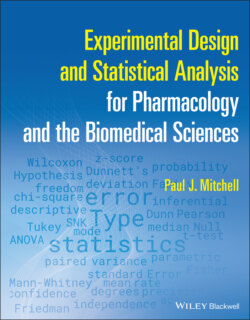Читать книгу Experimental Design and Statistical Analysis for Pharmacology and the Biomedical Sciences - Paul J. Mitchell - Страница 25
Errors in measurement
ОглавлениеIn all our experimental measurements, there will be various levels of accuracy and precision – as experimental pharmacologists, it is our responsibility to reduce as far as possible these potential sources of error in our observations. The problem is, however, no matter how hard we try, there will always be the possibility for error in our observations such that all measurements will have some degree of error.
The different sources of measurement error are as follows:
A blunder is where there is a gross mistake in recording data by, for example, recording the wrong value, misreading a scale. All blunders should be eliminated by recording data carefully. Blunders should not be included in the analysis of data.
An observer error may simply be an incorrect reading of a measurement or device. This is similar to a blunder but may be due to inexperience of the observer (e.g. recording the incorrect units of measurement; mg instead of g) or the incorrect recording of someone else's measurements. Such observational errors should be eliminated from any subsequent analysis unless the level of error can be accurately corrected.
A systematic error may occur if a machine is incorrectly calibrated. However, this may be compensated for if the degree of error is known. Systematic errors may be eliminated or corrected by the careful calibration of your equipment.
Random errors are positive and negative fluctuations in the data that are generally beyond the control of the experimenter. These may be unpredictable changes in ambient temperature, humidity, or lighting conditions or variations in human reaction time during manual measurement of time variables. The level of error may be reduced or even eliminated by taking repeated measurements (e.g. taking measurements in duplicate, triplicate, or more depending on the size of the error) to increase the accuracy of the reported, single, observation.
An instrumental error may occur if a piece of equipment is faulty and provides an incorrect reading. Generally, such issues are not apparent until after completion of the experiment. Such error data should be discarded.
So, the data we obtain from our experiments will always be a balance between our striving for accuracy and precision on one side against the possibility of an error in our measurements on the other side.
One method we may adopt to reduce error in our measurements and increase the precision of the data is to take repeated readings from the same sample. Unfortunately, however, such a process is often interpreted as producing independent observations, thereby increasing the number of samples in our data group(s). So, let us look at this more carefully and try to clear up any misunderstandings about this important issue.
